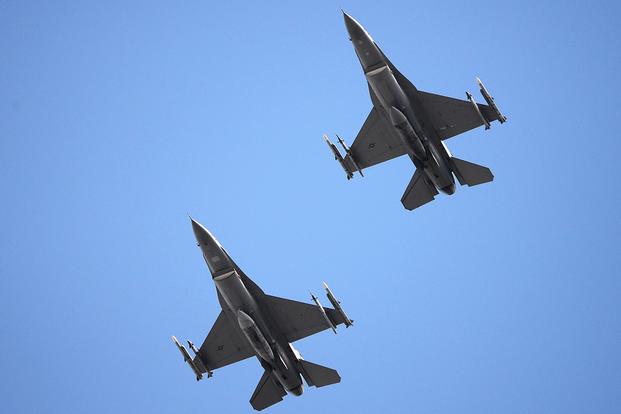Two F-16C Fighting Falcons collided head-on in a June 7, 2016, incident because one of the pilots failed to properly deconflict flight paths, the Air Force said Friday.
The crash took place at the Bulldog Military Operation Area close to Louisville, Georgia, and involved pilots assigned to two units: the 316th Fighter Squadron, 169th Fighter Wing; and the 157th Fighter Squadron, 169th Fighter Wing, both out of McEntire Joint National Guard Base, South Carolina.
Both pilots ejected and survived with minor injuries; the aircraft were destroyed, totaling a $60.8 million loss.
In November 2016, CBS news affiliate WRDW reported that debris was still being recovered, months after the crash. According to the Air Force release, it cost $90,000 to complete environmental cleanup from the crash.
According to an Air Force Accident Investigation Board report completed and released this month, the collision occurred at the end of a training mission, about 10 minutes after twilight.
Both pilots are described as experienced. The first mishap pilot was an instructor pilot leading the flight, according to the report. The second pilot, also an instructor, was flying in a wedge formation behind the first pilot's aircraft.
Close to the end of the flight, around 9:13 p.m., the second pilot issued a "bingo fuel" call, signaling an immediate return to base. In response, the first pilot executed a sharp left turn, according to the report.
The second pilot, following behind at about four nautical miles, was following the first pilot's lights by sight, but did not "cross-check available sensors" to get confirmation of the pilot's position, the report states.
As a result, the second pilot didn't realized the first pilot had turned and was now heading toward him, just 1,000 feet below his altitude. When the second pilot began to descend, the planes ended up on a collision course.
"[Mishap Pilot 2] acquired radar lock at 2,500 feet separation but failed to recognize the conflict. At the last moment, both aircraft initiated a left bank away from the other, but their high right wings impacted," the report stated. Neither [Mishap Pilot 1] nor MP2 were able to regain control of their aircraft, with both pilots ejecting shortly after impact."
The investigation found the first pilot should have called "Knock it off," signaling an end to maneuvers and return to base, while the second pilot should have cross-checked the position of the first rather than relying on visuals. The second pilot was assigned the brunt of the blame for failure to deconflict flight paths.
Officials with Air Combat Command said Friday that both pilots are still flying for the Air Force; queries about whether any administrative or disciplinary actions were taken as a result of the crash did not receive an immediate response.
The collision and findings bear striking similarities to a 2017 mishap involving two A-10C Thunderbolt II aircraft. The planes collided Sept. 6, 2017, near the Nevada Test and Training Range. An investigation, released earlier this month, found that one of the pilots climbed too far above his established altitude block and failed to deconflict flight paths with the other pilot.
-- Hope Hodge Seck can be reached at hope.seck@military.com. Follow her on Twitter at @HopeSeck.













